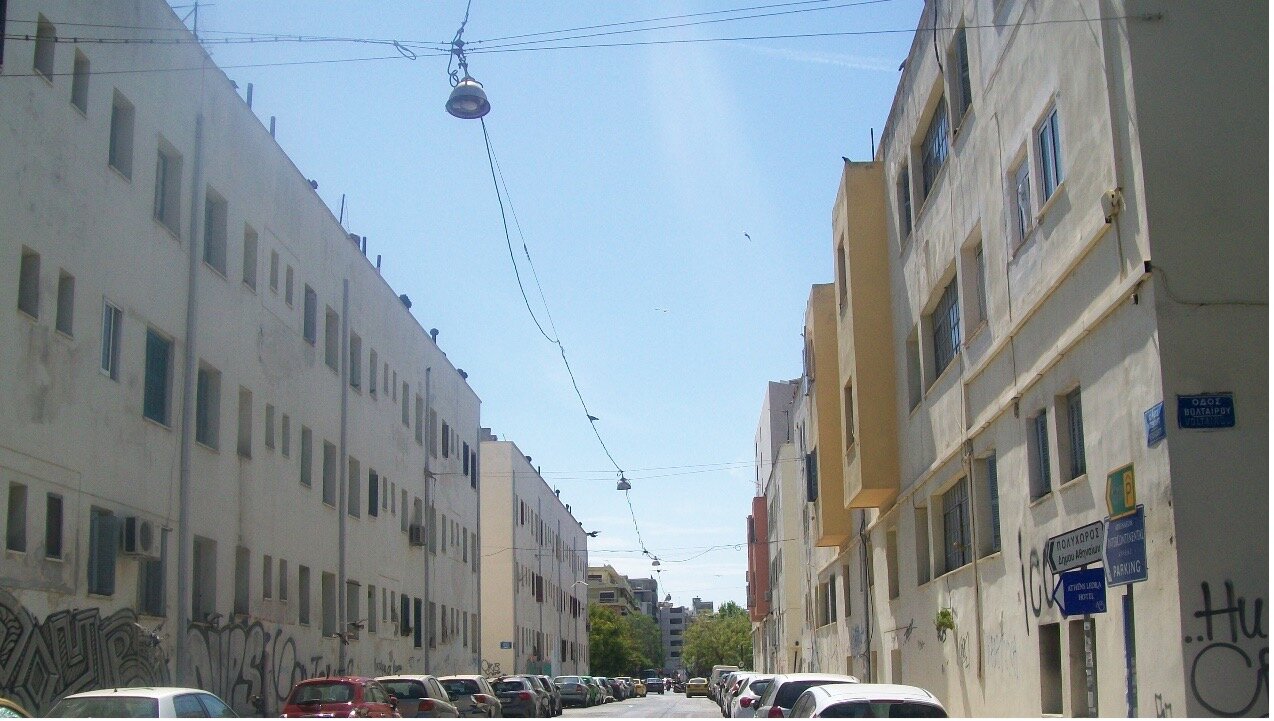Social Housing Estates in Athens: Development, Decline and Challenges
Nikolina Myofa, Harokopio University in Athens
The Greek housing system is part of the residual South European welfare model (Allen et al., 2004). Social housing was usually associated with slum clearing programmes and the construction of housing estates exclusively for homeownership targeted to specific population groups living in inadequate housing conditions (refugees, victims of natural disasters, internal migrants, salaried workers etc.). Greece is the only European country where the social rental sector has never been developed.
Figure 1. The first four apartment buildings in Dourgouti (Neos Kosmos district), part of the housing estates for refugees built in 1935-1936 by the Ministry of Welfare. Source: personal archive
The majority of housing estates was built in the metropolitan area of Athens where the inflows of new residents was more intense and the housing needs more urgent. The main providers of housing estates were the Ministry of Welfare, who provided housing for refugees in housing estates after the clearing of slum areas (figure 1); the Workers’ Housing Organization (OEK)—abolished in 2010—who provided owner occupied housing to private-sector workers and employees; and the Public Enterprise of Town Planning and Housing (DEPOS)—abolished in 2012—who provided affordable housing for low- and middle-income social groups through the renovation of a small number of old housing estates (figure 2).
From the interwar period until 2004, 19,299 dwellings in housing estates were constructed in the metropolitan area of Athens. Housing estates are concentrated in a few small areas and the share of their residents in the city—1.6 per cent in 2011—is very low (Kandylis et al., 2018) in comparison to other European cities (Hess et al., 2018). The sociodemographic features of their population broadly followed the trends in their surrounding areas from 1991 to 2011. Some dissimilarities persisted between census tracts with housing estates and those around them in terms of occupational categories, education level, and housing deprivation. For instance, the share of manual workers and housing deprivation remains higher in housing estates but the distance with the surrounding areas decreased. On the contrary, the share of university graduates and the share of migrants in housing estates remained lower and higher respectively and the difference from the surrounding areas increased for both between 2001-2011(Kandylis et al., 2018).
Figure 2. Part of the social housing estate in Tavros renovated by DEPOS. Source: personal archive
The existing housing estates currently face some significant challenges. Homeownership led initially to a quite homogeneous profile. This started to change in the early 1990s with the inflow of low-income households from neighbouring countries attracted by low rents. The fact that apartments in these blocks were meant for owner-occupation led this housing model to quickly loose its social character. The neighbourhoods of these housing estates would cease to be different from their wider areas once they followed the dominant homeownership model. The state quickly abandoned any responsibility for this housing stock and the owners were responsible for the maintenance and upgrading of their apartments and for the entire estate, despite of their poor financial situation. The financial inability of many owners led to the gradual degradation of the housing estates. The frequent abandonment of apartments in these estates intensified degradation. As a result, there is now a pressing need for their renovation, potentially through the reorganization of a public agency that could undertake the implementation of such a project with social criteria. An important asset is the buildings in these estates are historically significant and have an important architectural value.
The renovation of the apartment buildings could possibly bring back some of the former residents. Both the renovation and the return of former residents are a constant claim of the homeowners. Such a public intervention could enable the reuse of this stock as a particular form of social housing. Vacant apartments and those in limited use may be re-directed to some form of social housing, with the consent of their owners, in a period when increasing numbers of people do not have the means to find adequate housing.
References
Allen J., Barlow J., Leal J., Maloutas T. and Padovani L. (2004), Housing and Welfare in Southern Europe, Oxford: Blackwell Publishing Ltd.
Hess D. B., Tammaru T. and Van Ham (2018), Lessons Learned from a Pan-European Study of Large Housing Estates: Origin, Trajectories of Change and Future Prospects, in Hess D.B., Tammaru T. and Van Ham M. (eds.), Housing Estates in Europe: Poverty, Ethnic Segregation, and Policy Challenges, International Publishing: Springer, pp. 3-31.
Kandylis G., Maloutas T. and Myofa N. (2018), “Exceptional social housing in a residual welfare state: Housing estates in Athens”, in Hess D.B., Tammaru T. and Van Ham M. (eds.), Housing Estates in Europe: Poverty, Ethnic Segregation, and Policy Challenges, International Publishing: Springer, pp. 77-98.

